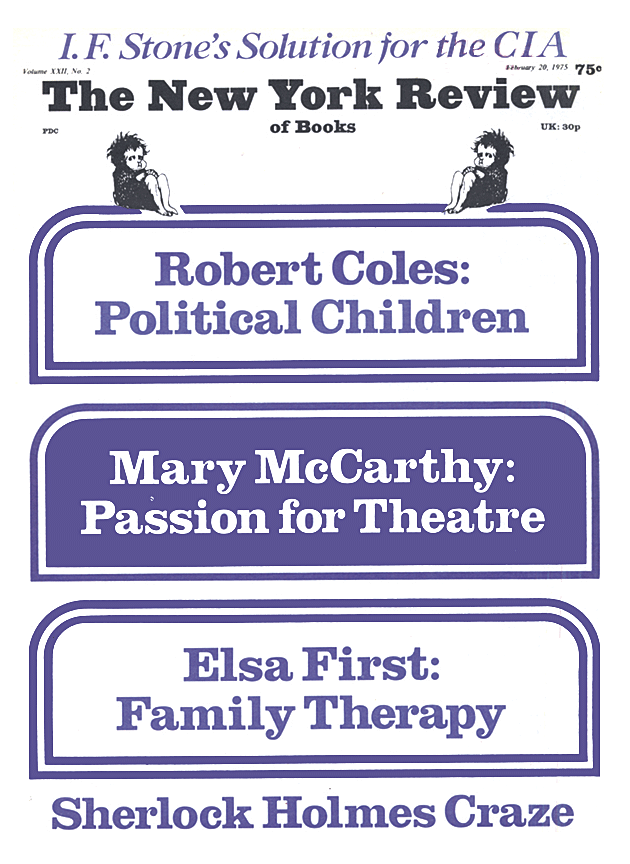In response to:
A Sullied, Sallied, Solid Text from the December 12, 1974 issue
To the Editors:
Stephen Booth deals very graciously with my general introduction to The Riverside Shakespeare (NYR, December 12). Hence I am surprised at the ungraciousness—not to say the incomprehension—with which he treats the most important feature of the book, the text of G. Blakemore Evans. Most of Mr. Booth’s specific “quibbles” (his word), one of which he characterizes as “illegitimate,” boil down to a demand for simplification. But this would be just the kind of oversimplification that has impaired the authority of other modernized texts. Granted that the aim is to bring Shakespeare as close as possible to the reader, the editor cannot do so except by removing the encrustations of earlier editors and by consistently bracketing relevant language which does not appear in the copy-text.
For example, there is no need to do so with “sallied” because it is in the authoritative Second Quarto of Hamlet; the archaic spelling of “sullied” has here been retained because it registers a phonetic distinction; while the textual note provides further justification, as well as listing the better known—but less probable—Folio reading, “solid.” Or, to cite another cavil almost at random, when Mr. Booth confesses that he was misled as a schoolboy by an interpolated stage-direction in 2 Henry IV, that scarcely gives him warrant to reproach Mr. Evans for having left the interpolation out. Literary scholarship during recent years has witnessed striking advances in editorial method, and Professor Evans has taken the fullest advantage of this exacting discipline. When Professor Booth speaks of “variations,” where presumably he means “variants,” he reveals a technical naïveté.
Since his review begins with a close reading of the Riverside title-page, and since he draws from it an ungenerous inference, I should like to clear the matter up. Dr. Marie Edel is a very able textual scholar who acted as coordinator and copy-editor for the Houghton Mifflin Company (having previously performed a similar function for The Pelican Shakespeare). For reasons of house policy, it was not originally intended that her name be listed among the editors. Those of us who worked with her came increasingly to realize the central importance of her contribution. The publishers were finally persuaded to recognize it in this way, and they determined the sequence of names.
Mr. Booth professes a distaste for commercial exploitation, which I share with him. But I am therefore at a loss to understand the zeal with which he puffs the Pelican edition. Since I happen to be a co-editor of both editions, I can watch the competition with some equanimity. Both have many merits, if I may say so; yet it can objectively be noted that the Riverside is strongest where the Pelican is relatively weak; the text the latter offers has been prepared piecemeal by thirty-five different editors. Moreover, when Mr. Booth states that the first two pages of The Merchant of Venice cover 123 lines in the Riverside and 145 in the Pelican, he should perhaps have also noticed that those pages contain sixty-one lines of notes in the Riverside to twenty-four in the Pelican.
As for The Harvard Concordance to Shakespeare, its compendiousness and accuracy might have been more fairly assessed by comparison with the single volumes of Marvin Spevack’s predecessors, Bartlett and Cowden Clark. I too prefer the absolute completeness of the six-volume concordance published in Germany by Professor Spevack a few years ago. But the difference between one huge volume and six rather large ones, as a fair-minded reviewer might have pointed out, is likewise a difference between forty-five dollars and something like two hundred.
Harry Levin
Harvard University
Cambridge, Massachusetts
Stephen Booth replies:
I am grateful for the opportunity to respond to Professor Levin’s letter. To do so, however, might unreasonably dignify the logic of his particular arguments and might just as unreasonably tend to obscure his generosity in trying to find some. The letter is an admirable gesture of loyalty and is best let stand as such.
This Issue
February 20, 1975


